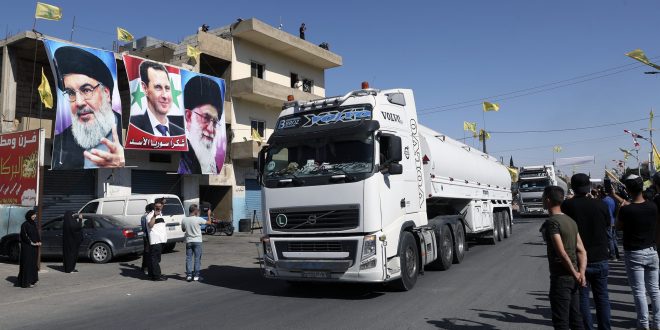The fall of Assad marks a pivotal blow to Iran’s regional strategy, reshaping its influence in the Middle East.
Radical shifts in the regional balance of power have forced Iran to reconsider its long-held foreign policy of propping up anti-U.S. and anti-Israel forces—the so-called “Axis of Resistance,” a strong network of proxy groups that have threatened Tehran’s enemies while shielding the regime from direct danger. This network includes Hezbollah in Lebanon, Hamas and Palestinian Islamic Jihad in Gaza, the Houthis in Yemen, and various Shia militias in Syria and Iraq. It also included the Assad regime in Syria, the only actor to leverage the state apparatus in support of Iran’s aims. By using asymmetric warfare to weaken enemies and offset the United States’ conventional military advantages, the Axis of Resistance enabled Iran to confront its competitors with some degree of deniability.
Through years of financial, military, and logistical assistance, Tehran guaranteed that these proxies could further its wider geopolitical goals of increasing its influence throughout the Middle East, threatening its adversaries, and preventing regional conflicts from reaching Iranian territory.
Severing the Shia Crescent
Iran’s aspirations to regional hegemony center on the “Shia Crescent,” a vital land route that connects Iran to the Mediterranean via Iraq, Syria, and Lebanon. Tehran uses this corridor to preserve its regional ties and project its influence. And, of course, Syria stands as the keystone of the Shia Crescent— a crucial node through which Iran can directly provide assistance to Hezbollah and its other proxies.
But recent events, like Iran’s troop pullout from Syria, pose questions about the corridor’s future. Iran’s capacity to exert pressure on Israel and support its proxies would be weakened if its presence in Syria were to decline. Indeed, Iran’s geopolitical goals vis-a-vis the Arab-Israeli conflict are seriously threatened by the potential collapse of the Shia Crescent.
The ramifications of Assad’s fall will almost certainly be felt in Iran itself, too. The ouster of the Assad regime might bolster opposition forces and exacerbate economic difficulties within the Islamic Republic. Perhaps most importantly, the loss of Syria will likely undermine the narrative of regional dominance that the authorities in Tehran have spread at home to justify their foreign adventurism. Moreover, the emergence of a new government in Syria backed by the West could drastically shift the balance of power in the Middle East. Iran’s tens of billions of dollars of investments in its erstwhile ally would be lost, with little to show for it.
To make matters worse, a leadership void has resulted amid Assad’s flight to Russia, upending the established power structure and inviting external powers to influence the emergent regime. Regional states, including the monarchies of the Gulf and Turkey now have the chance to assert themselves in the power vacuum. The situation is complicated by the lack of a clear Assad successor, which raises the possibility of protracted instability and infighting among Syrian power players. The geopolitical dynamics facing policymakers in Tehran have become even more problematic, as regional and international powers jostle for influence.
Iran’s Shifting Strategy
Iran’s recent moves suggest that leaders in Tehran may shift how they handle competition and confrontation with regional adversaries. The removal of important military figures points to a shift away from proxy warfare and toward a more direct approach that prizes conventional military forces.
The Islamic Revolutionary Guards Corps (IRGC) and Basij, which are in charge of Iran’s asymmetric warfare capabilities, are expected to receive a sizable amount of the 200 percent increase in Iran’s military budget. Furthermore, the “deterrence/warfighting triad“—a guerilla navy, long-range missiles and drones, and foreign proxies—continues to be a major component of Iran’s military policy.
Furthermore, Iran has acknowledged the limitations of its conventional military capabilities by concentrating on asymmetric instruments such as asymmetric naval capabilities, medium- to long-range missiles, and drones that are developed domestically. The “Axis of Resistance” network, which consists of organizations like the Houthis, Hezbollah, and Hamas, is still maintained and grown by the Iranian government. These arguments imply that rather than moving toward a more traditional military strategy, Iran is preserving, if not enhancing, its dedication to proxy warfare and asymmetric capabilities.
The focus on achieving deterrence through national military forces reflects Tehran’s desire to achieve greater control over its security. While non-state groups like Hamas and Hezbollah continue to be crucial to Iran’s regional goals, they will no longer be prioritized as a matter of national strategy. Indeed, it appears that Iran has already made the decision to withdraw members of its elite Quds Force from Syria in the wake of Assad’s ouster.
Iran’s leaders must also contend with a potential return of the Trump administration’s “maximum pressure” campaign, which slashed Iran’s government revenues from 2018-2021. Hezbollah and Hamas have been decimated by Israel, and Tehran may find it more difficult to re-equip its proxies due to economic restrictions that target Iran’s financial networks and oil exports. Additionally, Iran’s neighboring alliances have been damaged by diplomatic isolation, making it more difficult for it to maintain its influence.
Iran’s influence has been weakened by strained partnerships across important regions as a result of its diplomatic isolation. After Azerbaijan won the Nagorno-Karabakh war, Iran’s influence in the Caucasus has waned as Azerbaijan fortifies its relations with Iran’s adversaries, Israel and Turkey. Similarly, Iran’s ongoing support for extremist groups throughout the Middle East has left Gulf Cooperation Council (GCC) states skeptical, even in the face of recent attempts to mend fences. Cairo has shown little interest in reestablishing diplomatic relations following a 45-year break and attempts to make amends with Egypt have likewise failed.
Long-term openings at important embassies, including those in London and Paris, reflect the widening gap, and relations with European countries have also deteriorated. European nations have become even more hostile toward Iran because of its military assistance to Russia in the situation in Ukraine. These events highlight Tehran’s difficulties preserving its regional clout and connections, further isolating it on the international scene.
Iran’s growing connections with China, Russia, and the Gulf states offer Tehran access to political and economic backing, which could diminish the effects of diplomatic isolation and sanctions.
Iran is likely to continue, albeit with less capacity, to fund organizations like Hezbollah and Hamas despite the setbacks of the past year. Using new alliances or its current proxies, Tehran may employ fresh tactics to hold onto power and continue to oppose Israel—tactics that may cause further escalations of violence. As evidenced by Iran’s unprecedented strikes on Israel this year, the weakening of the so-called “Axis of Resistance” increases the likelihood of direct conflict between Israel and Iran.
Iran’s broader strategic calculations will be significantly impacted by the breakdown of the Shia Crescent, which marks a turning point in Middle Eastern geopolitics as the new ruling forces in Syria come together. Recent developments have put Tehran’s leadership under extraordinary political and economic duress by stifling Iran’s ability to project influence, disrupting its long-standing proxy network, and severing vital land linkages to significant allies. Iran’s proxy network, which Tehran saw as a defense mechanism and a way to increase its influence throughout the region, has probably suffered irreversible harm because of losing Syria as a trustworthy and obedient friend. This loss is especially noteworthy because Syria was a vital route for Iran to support Hezbollah in Lebanon by allowing Tehran to move supplies and weapons across the Syrian border.
The emerging power vacuum further complicates regional dynamics by forcing regional actors to realign and capitalize on the new strategic realities. The collapse of Syria destroyed a crucial element of Iran’s regional strategy, meaning that the “axis of resistance” as it was known no longer existed. As a result, Iran is now isolated and has less capacity to exert influence throughout the Mediterranean7. Iran’s capacity to sustain its influence in nations like Lebanon and portions of Iraq, as well as its regional stance, are all impacted by the loss of Syria as a strategic partner.
The Middle East has changed due to the fall of Iran’s proxy strategy, and Tehran is finding it difficult to regain its sway in the altered geopolitical environment. Iran’s capacity to utilize Shiite militias in Syria and Iraq and the Houthis as proxies has been greatly reduced due to their weakness. This might compel a change to direct conflicts or traditional military strategies, posing problems and chances for regional nations and the global community to reshape the Middle East’s security framework.





